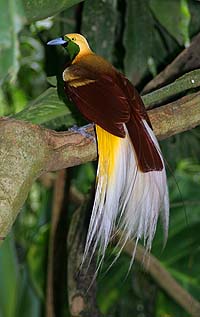Bird-of-paradise
| Birds of paradise | |
|---|---|

| |
| Adult male Lesser bird-of-paradise, Paradisaea minor | |
| Scientific classification | |
| Kingdom: | |
| Phylum: | |
| Class: | |
| Order: | |
| Suborder: | |
| Family: | Paradisaeidae
|

The birds of paradise are songbirds of the family Paradisaeidae. They live in eastern Indonesia, Maluku, Papua New Guinea, Torres Strait Islands, and eastern Australia. Best known are the members of the genus Paradisaea, including the type species, the greater bird-of-paradise, Paradisaea apoda.
They live in tropical forests like rainforests, swamps and moss forest. They build their nests from soft materials, such as leaves, ferns, and vine monsters, typically placed in a tree fork.[1]
These birds are best known for the remarkable plumage and behaviour of the males. They are an extreme example of how sexual selection works.[2]
Females choose males who they instinctively see are fine specimens of their species. The colours of the plumage, the construction of the nest, the song and the mating dance all play a part. In some species the pairing is monogamous, and in others the males are polygamous. If they are monogamous, the males look much like the females. If they are polygamous, the males are very much flashier than the females. In both cases, it is the female who makes the choice of partner.
Hunting for plumes and habitat destruction have reduced some species to endangered status. Habitat destruction due to deforestation is now the main threat.[3]
Birds of paradise range in size from the king bird of paradise at 3 grams (1.8 oz) and 15 cm (6 in) to the black sicklebill at 110 cm (43 in) and the curl-crested manucode at 430 grams (15.2 oz).
Birds of paradise have bodies which look rather like a crow. They have stout or long bills and strong feet, About two-thirds of the species are strongly sexually dimorphic.
In most species, the diet is mostly fruit, but riflebirds and sicklebills also prefer insects and other arthropods.[1]
Species of birds-of-paradise[change | change source]
Genus Lycocorax
- Paradise-crow, Lycocorax pyrrhopterus
Genus Manucodia
- Glossy-mantled manucode, Manucodia atra
- Jobi manucode, Manucodia jobiensis
- Crinkle-collared manucode, Manucodia chalybata
- Curl-crested manucode, Manucodia comrii
- Trumpet manucode, Manucodia keraudrenii
Genus Paradigalla
- Long-tailed paradigalla, Paradigalla carunculata
- Short-tailed paradigalla, Paradigalla brevicauda
Genus Astrapia
- Arfak astrapia, Astrapia nigra
- Splendid astrapia, Astrapia splendidissima
- Ribbon-tailed astrapia, Astrapia mayeri
- Stephanie's astrapia, Astrapia stephaniae
- Huon astrapia, Astrapia rothschildi
Genus Parotia
- Western parotia, Parotia sefilata
- Carola's parotia, Parotia carolae
- Berlepsch's parotia, Parotia berlepschi
- Lawes's parotia, Parotia lawesii
- Eastern parotia, Parotia helenae
- Wahnes's parotia, Parotia wahnesi
Genus Pteridophora
- King of Saxony bird of paradise, Pteridophora alberti
Genus Lophorina
- Superb bird-of-paradise, Lophorina superba
Genus Ptiloris
- Magnificent riflebird, Ptiloris magnificus
- Eastern riflebird, Ptiloris intercedens
- Paradise riflebird, Ptiloris paradiseus
- Victoria's riflebird, Ptiloris victoriae
Genus Epimachus
- Black sicklebill, Epimachus fastuosus
- Brown sicklebill, Epimachus meyeri
- Black-billed sicklebill, Epimachus albertisi
- Pale-billed sicklebill, Epimachus bruijnii
Genus Cicinnurus
- Magnificent bird-of-paradise, Cicinnurus magnificus
- Wilson's bird-of-paradise, Cicinnurus respublica
- King bird-of-paradise, Cicinnurus regius
Genus Semioptera
- Wallace's Standardwing, Semioptera wallacii
Genus Seleucidis
- Twelve-wired bird-of-paradise, Seleucidis melanoleuca
Genus Paradisaea
- Lesser bird-of-paradise, Paradisaea minor
- Greater bird-of-paradise, Paradisaea apoda
- Raggiana bird-of-paradise, Paradisaea raggiana
- Goldie's bird-of-paradise, Paradisaea decora
- Red bird-of-paradise, Paradisaea rubra
- Emperor bird-of-paradise, Paradisaea guilielmi
- Blue bird-of-paradise, Paradisaea rudolphi
Greater "melampitta"
- Greater melampitta, "Melampitta" gigantea - tentatively included in this group
Formerly placed here
- Loria's bird-of-paradise, Cnemophilus loriae - probably closer to Melanocharitidae (berrypeckers) (Cracraft & Feinstein 2000).
- Crested bird-of-paradise, Cnemophilus macgregorii - probably closer to Melanocharitidae (Cracraft & Feinstein 2000).
- Yellow-breasted bird-of-paradise, Loboparadisea sericea - probably closer to Melanocharitidae (Cracraft & Feinstein 2000).
- Macgregor's giant honeyeater (formerly "Macgregor's bird-of-paradise"), Macgregoria pulchra - recently found to be a honeyeater (Cracraft & Feinstein 2000).
- Lesser melampitta, Melampitta lugubris - for some time tentatively placed here; probably Orthonychidae (logrunners)
References[change | change source]
- ↑ 1.0 1.1 Frith, Clifford B. (1991). Forshaw, Joseph (ed.). Encyclopaedia of Animals: Birds. London: Merehurst Press. pp. 228–231. ISBN 1-85391-186-0.
- ↑ Irested, Martin et al 2009. An unexpectedly long history of sexual selection in birds-of-paradise. Evolutionary Biology 9 (235): 235. [1]
- ↑ Firth, Clifford B. & Dawn W. 2009. Family Paradisaeidae (Birds-of-paradise). In del Hoyo, Josep et al (eds). Handbook of the Birds of the World. Volume 14, Bush-shrikes to Old World Sparrows. Barcelona: Lynx Edicions. pp. 404–459. ISBN 978-84-96553-50-7
Other websites[change | change source]
- BBC Arts: Painting paradise: Art meets nature in Papua New Guinea. [2]
- Birds of Paradise Archived 2009-01-31 at the Wayback Machine
- Streaming video of a few birds of paradise's courtship display Archived 2011-02-04 at the Wayback Machine
